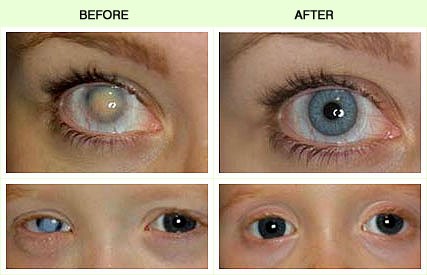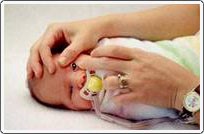Introduction
Parents frequently ask this question whenever their child is advised to wear contact lenses for optical correction. Actually there is no specific age limit to start wearing contact lenses. Contact lenses can be worn at any age as long as the parameters of the cornea can be matched with the curvature and diameter of the lenses. Contact lenses can be prescribed as early as the age of infants, for valid reasons as long as the child’s eyes can tolerate well when wearing contact lenses.
Children who are capable of managing themselves and perform their daily responsibilities well, such as looking after their personal hygiene, are excellent candidates for contact lenses. On the other hand, for children who are not yet ready to look after themselves, it is their parents or guardians’ duty to put on and take off their children’s contact lenses, including the care involved. However, parental concerns about complications, infections and difficulties faced by the child wearing contact lenses cannot be denied.
Scientific research has proven that wearing contact lenses at a very young age gives optimum benefit to the children if everyone involved follows the guidelines for handling contact lenses, as instructed by ophthalmologists or optometrists. In a recent study that involved fitting contact lens in children at age 8-11 with one-day disposable contact lenses, 90 percent of the kids had no trouble applying or removing the contacts without assistance from their parents. Studies have also shown that the incidence of contact lenses complications was low among children aged 8-12 years and most high among users aged 18-25 years by 3.5 times. Plus, younger children sometimes follow instructions about contact lens wear better than teenagers and young adults, so they may have fewer problems with over-wearing their contacts or not using the correct contact lens solutions. Children also have tears of better quality compared to adults, whereby the quality of tears is very important for contact lens wearers.
Refractive error in children from birth till 8 years old should be given priority in correction in order to prevent from dense amblyopia that may have a big impact on them when they grow older. Amblyopia (lazy eye) is a common effect of refractive error which is not corrected at an early stage (refer to amblyopia/lazy eyes article). Contact lens is an alternative to correct refractive errors in both children and adults.
Conditions That Require Children To Wear Contact Lenses
Anisometropia is a different refractive power between the two eyes more than 2.00D. Individuals who suffer from this problem usually feel uncomfortable when using glasses due to binocular imbalance. The use of contact lenses can eliminate the effects of these imbalances and provide better stereo acuity to the patients.
Aphakia is the eye that does not have the crystalline lens. The main causes of blindness in children are presence of paediatric cataracts. Children who are born with cataracts will usually undergo surgical removal of the crystalline lens. If for some reason intraocular lens did not inserted into the baby’s eye, the contact lens become the best optical correction at that time especially for unilateral cataract. Clinical studies designed to compare the visual outcome of children who are pseudophakic with aphakic contact lens corrected, children are failed to exhibit statistically significant difference in visual acuity. Unfortunately in view of child’s physical appearances, if spectacle correction be the first choice after surgery, the child may seem less interesting, strange compared to other children and uncomfortable because the lens is thick, heavy and have limitation in the field of view. In some circumstances, study has proved that wear a contact lenses often can improve how children feel about their appearance, elevating their self-confidence and also easy to get along with friends.
Contact Lens For Extreme Sport
It is not recommended for players who play contact sports to wear spectacles. The use of soft contact lenses along with other protective eyewear permitted during sport is more practical and safer.
Among the advantages of using contact lenses during sports are:
- There are no obstacles in the visual field of players by spectacle frames and give wider peripheral vision.
- The uses of glasses lens easily get misty due to climate change and the environment, such as rain. Sometimes can fog up during competition, affecting vision and performance.
- Low risk to get eye injury.
- Give better and stable vision with heavy movement such as running.
- Improving self-confidence and more competitive players during sports.
- There are also have customized contact lenses for players who need protection from ultraviolet radiation from sunlight like outdoor sport.
Uneven Cornea like keratoconus or children who underwent corneal transplants and so on may contribute to an irregular astigmatism and will lead to reduction in vision and glare. Semi- hard types of contact lenses are very suitable for this problem.
Controlling Myopia
Myopia is one of the refractive errors which the child will have blurring of vision at distance. The severity of myopia is depending on eye power. The myopia have tendency to increase in children until reaching a certain age. Various approaches have recently been suggested including orthokeratology lenses specifically designed to control myopia. Studies conducted at the University of Ohio and the Polytechnic University of Hong Kong found that the decline in the power of the eye for people with myopia when using orthokeratology lens which is a lens that is used during sleep. Furthermore these approaches, and the size of the effect, need to be supported by large-scale, long-term studies.
 Picture 1: Fitting Assessment For Orthokeratology Lens
Picture 1: Fitting Assessment For Orthokeratology Lens
Cosmetic
Children as well as adults have potential to get such as scarring of the cornea, aniridia (absence of the iris) and heterochromia (iris color differs both eyes) which cause physical inequality in both eyes. This can make the child embarrassment and loss of self-confidence. Therefore prosthetic contact lenses can be used for the purpose of closing the defect on the eyes so that their physical appearance are more attractive as well as enhancing their self-confidence to deal with the public

Picture 2: Scar At Right Eye
Which Contact Lenses Are the Best?
There are various types of contact lenses. Every types of contact lens have their own specialty. The question is which one is suitable to be used by the children?. Basically, there is no much different between contact lenses for children and adults. It’s depending on the purpose why we use the contact lens. Consult with you optometrist or contact lens practitioner qualified. He or she is the best person to help you decide what’s right for your children. Here is a common type of contact lens being used according to your child’s eyes condition.
|
Lens Type |
Lens Description |
Suitable Cases |
|
Soft contact lens
|
|
|
|
Rigid gas-permeable lens (RGP) |
|
|
|
Scleral lenses/hybrid contact lens.
|
|
|
|
Orthokeratology lens
|
|
|
A Parent’s Guide To Children Wearing Contact Lenses
When your child is advised to wear contact lenses usually ophthalmologist or optometrist has considered the effects of good and bad results of the application. No optometrist will prescribe contact lenses for children who are not ready for them or who do not have a good reason to wear them. Somehow they do not hesitate to unprescribe them if a child does not take good care of them. Parents play important role in the successful of contact lens application to their child. This following guide should be taken into account:
- Try to find information and get proper consultation from the ophthalmologist, optometrist or contact lens practitioner qualified in respect of children’s eye problems.
- Be prepared of yourself with a little knowledge and guide how to use contact lenses appropriately. Refer do and don’t in the article proper care of contact lenses
- Parents and guardians of children who are supposed to use contact lenses have to be committed and high motivated because preparing contact lenses to children involves time, cost and patience. Whatever the age of the patient, supervision are required most of the time. Lens handling, insertion, removal and cared properly are really important.
- Always alert about the child’s eye problem, any changes in your child’s eyes every time before and after application of contact lenses.
- Inform the guardian of your children, such as teachers or maid about contact lens on your child’s eye and the initial steps that can be done in the event of an emergency during your absence. Its better they know everything that you know.
- Try educates children to become more disciplined to manage their contact lenses properly.
- Find out whether your child is mature enough to distinguish the good between contact lenses and eyeglasses. If they manage to do so, your child may have been able to manage their contact lenses properly. However, parental monitoring is still required. Refer to articles contact lenses for children.
- Try and find support group among parents and shared the experienced. Believe that it can make a huge difference. You are not the only one out there its can increase your motivation.
- Obey every appointment for contact lens follow up.

Picture 3: Neonate Being Fit With Contact Lenses
The successful use of contact lenses to children depends on continuity cooperation of parents, optometrists and other eye care professional. The risk of contact lens–related corneal infections can be avoided as minimal as if parents care for the contact lenses properly. Most optometrists and other professional eye care reporting that excellent results regarding the use of contact lenses in children.
References
- Robert H. Duckman (2006). Visual Development, Diagnosis, and Treatment of the Paediatric Patient. Published by ,F: Lippincott Williams &Wilkins, A Wolters Kluwer business .Peadiatric and Adolescent Contact Lens Correction ,Chapter 15 ( Page 260-277)
- Peadiatric and Adolescent Contact Lens Correction ,Chapter 15 ( Page 260-277)
- Nor Aini Hanafi(18 Jun 2014). Mata Malas (Ambliopia). Diambil 1 April 2015 dari http://myhealth.moh.gov.my/index.php/my/umum/optomeri/mata-malas-ambliopia
- Syuhairah bt Hamzah (20 Jun 2014). Siapa Yang Layak Memakai Kanta Lekap?. Diambil 1 April 2015 dari http://myhealth.moh.gov.my/index.php/my/umum/optomeri/siapa-yang-layak-memakai-kanta-lekap
- Azalia bt. Razali. (19 Mac 2014).Pemakaian Kanta Lekap yang Selamat. Diambil 1 April 2015 dari http://myhealth.moh.gov.my/index.php/my/pemakaian-kanta-lekap-yang-selamat
- Shah Farez Othman (26 November 2009) . Kanta Sentuh Untuk Kanak-kanak. Diambil 1 April 2015 dari http://myhealth.moh.gov.my/index.php/dewasa/gaya-hidup/penjagaan-mata
- http://www.aao.org/publications/eyenet/201203/pediatrics.cfm
- http://www.optometry.co.uk/uploads/articles/cet_2-2801-use_thsi_version%281%29.pdf
- Gambar 1 : http://www.gpspecialists.com/wp-content/uploads/2012/11/ortho-k2.jpg
- Gambar 2: http://www.adityajyoteyehospital.org/contact_lenses.aspx
- Gambar 3 : http://www.wrighteyecare.com/patient-education/cataracts/
| Last Reviewed | : | 17 Oktober 2016 |
| Writer | : | Pn. Halijahton Binti Abdol Rahim |
| Translator | : | Pn. Halijahton Binti Abdol Rahim |
| Accreditor | : | Pn. Rosmawati Binti Uthman |







